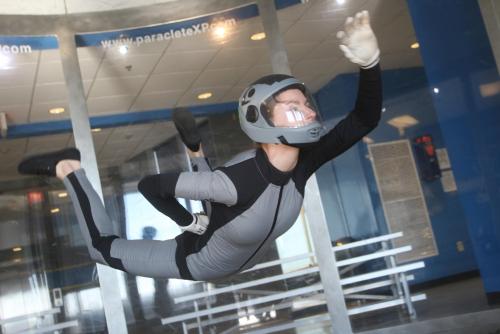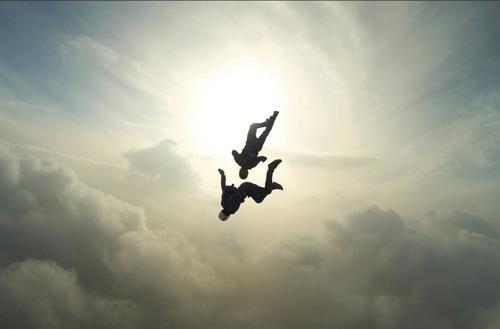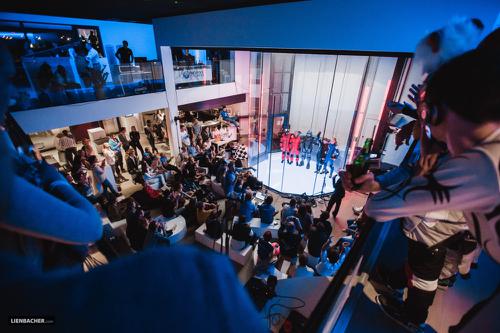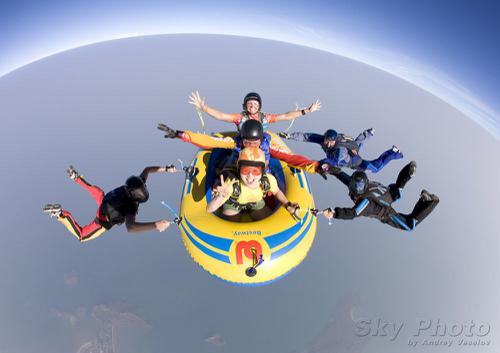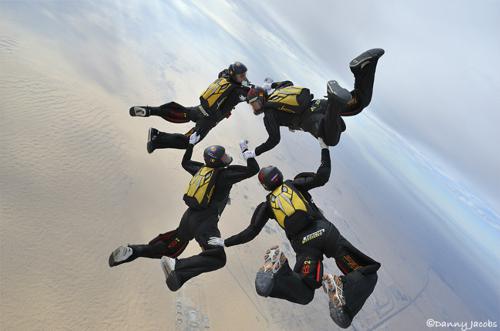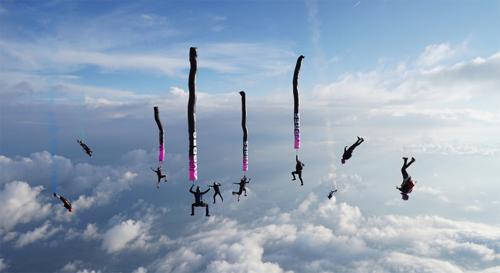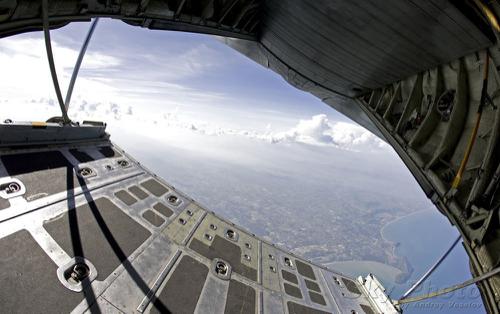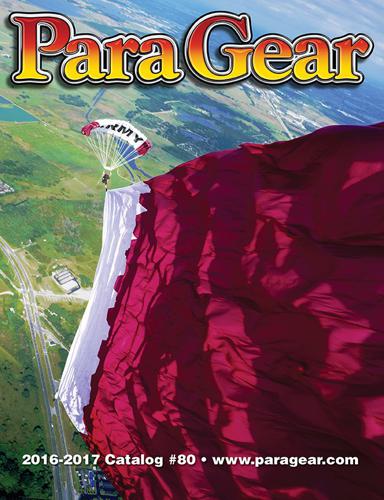From Tunnel to Sky
Training Wind Tunnel Students to be Great Skydiving Students
by Kirk Verner and Gary Peek
Photos by Michael Breweri
Tunnel student Emily Young
The advent of vertical wind tunnels has created not only an incredible new air sport, but has also provided us with a very realistic simulation of freefall skydiving. This simulation can be used to provide both accurate and efficient training for skydiving students.
As wind tunnels proliferate around the world, more and more people are going to begin skydiving having already experienced flight in a wind tunnel. Many of them will come to skydiving having performed maneuvers that skydiving students experience not only in their initial skydives, but in their more advanced training jumps as well.
At some point, nearly every dropzone and skydiving instructor will need to plan how to use this technology to both enhance and replace traditional training for freefall.
Advice for the tunnel instructor:
Keep in mind that the sport of skydiving and the skydiving industry are extremely concerned about legal issues and liability. Trusting a student's instruction outside of the normal skydiving channels is a huge leap of faith for both dropzones and skydiving instructors. It may be a long time before tunnel training for skydiving gains widespread acceptance, so have patience and try to cover all the bases during this transition.
In all likelihood, a tunnel instructor is going to have to hold a skydiving instructional rating from a national organization in order for their instruction to be used toward skydiving, for example, an USPA AFF instructional rating in the US.
Logging tunnel skills and experience
In order for a person trained in a tunnel to transfer their skills and experience to skydiving, they are going to need some reasonable verification of their training. Tunnel management and tunnel instructors would do well to create their own logbook to help their students take proof of their time and skills to dropzones and skydiving instructors. This logbook should include items like the date, location, flight time, maneuvers, and instructor signature, but could also include multiple ways to contact the instructor, since using proof of tunnel training will be new to many dropzones and skydiving instructors. They will likely feel much more comfortable with their skydiving student if they can discuss their tunnel training with the tunnel instructor if needed. If a specialized tunnel logbook is not available, a skydiving logbook could be used just as well, with the advantage of the student already having a logbook when they start skydiving.
Suggested progression for a tunnel student working toward being a skydiving student
In order to allow an AFF instructor who does not have tunnel flying experience to feel comfortable with the progression of students you have trained in the tunnel, there are a number of skills that the student should be able to demonstrate. These can range from basic stability all the way to advanced maneuvers, depending on the amount of time spent on instruction in the tunnel.
In most cases, a single phase of tunnel training will be all that a potential skydiving student will need. If the goal of the tunnel student is to skydive, they may be eager to do that as soon as possible.
In some cases however, a tunnel student may have begun tunnel flying without the goal of skydiving in mind, and may have accumulated significant time in the tunnel before deciding to skydive. Or, they may prefer the efficiency of the tunnel to learn the more advanced maneuvers before skydiving. If the skills outlined in a second phase of training are learned, the student may be able to advance very quickly in their skydiving progression.
Phase 1 -
Phase 1 training would include basic stability, neutral body position, heading control, fall rate control, forward and backward motion, docking, simulated altimeter checks, and simulated pilot chute throws. This training can be used to provide the student with the basic stability and maneuvers to allow them to jump with a single AFF instructor and to quickly advance to skydives and aircraft exits that will deliberately introduce instability.
Phase 2 -
Phase 2 training would include controlled turns, intentional unstable maneuvers, "delta" and tracking body positions, and the backslide body position. This additional training can be used to allow the student to quickly perform the maneuvers necessary to advance to the "coached" phase of skydiving training.
Ways to add realism to skydiving training in a tunnel
In order to provide a more realistic simulation of skydiving, a tunnel instructor may have their student wear a skydiving rig along with one of the "Tunnel Wrap" or "Rig Condom" devices, used to enclose skydiving rigs in order to prevent accidental deployments when worn in tunnels. Also, a simulated altimeter training device can be helpful to allow the student to practice the position of their arm when checking altitude.
Advice for the skydiving instructor:
For legal liability reasons, all skydiving students need to be given instruction in all areas related to making a skydive. However, most of us realize that students that have been trained in a wind tunnel, especially in skills related to skydiving, are going to progress through the skydiving freefall skills at a rate that no traditional skydiving student could. This may allow for a considerable savings to the student in time and number of jumps.
In all likelihood, a skydiving instructor is going to have to hold an instructional rating from a national organization in order to be be allowed to train students, for example, an USPA AFF instructional rating in the US.
Aircraft
A skydiving student of any kind may have no knowledge at all about aircraft and the dangers that they can present. Students need to know how to avoid propellers, enter the aircraft and position themselves properly, to protect their handles, and to find and wear their seatbelts. Remember that tunnel students are probably not used to having a rig on their back and may not realize what the flaps are rubbing up against.
Since most skydiving exits from aircraft are difficult to simulate in a tunnel, a skydiving instructor will need to tell the student what to expect for a particular exit. The advantage for a tunnel trained student is that if an exit causes instability, the student will be able to correct this almost immediately and quickly continue with the skydive.
Gear
One thing that many tunnel students are unlikely to have experienced is having a parachute system on their back while flying. If the student rig is sized well for the student and adjusted well on their back, this will likely not be an issue at all since they have learned and felt a great deal of stability in their body during tunnel flight. However, if your dropzone is one of those who still uses one-size-fits-all student rigs with large parachute for all students you will need to pay close attention to the adjustment of the rig if the student is a small person.
If a tunnel student has been flying in a tunnel for a while, or is very serious about tunnel flying, they may already have their own jumpsuit, helmet, and goggles. Their jumpsuit may or may not have grippers, so an instructor may not be able to easily take a grip on the student, but then again, why might they need to? If the student has enough tunnel time it is very unlikely that the instructor would need to take grips to control the student, but perhaps they would feel uncomfortable without grippers. If the student is required to wear the dropzone's jumpsuit it should be appropriately sized and probably be rather tight unless they are a larger student.
If the student's personal helmet and eye protection is appropriate for skydiving then having them use their own gear would be best. But if the student is required to wear a radio for canopy guidance there might be some serious tradeoffs. If the dropzone uses radios that are mounted on the helmet, the student may need to wear the dropzone helmet and goggles. However, if the radio is mounted on the student's chest strap, then perhaps telling the student to raise the face shield on their helmet once under canopy to hear the radio better might be sufficient.
Where will they be placed in our progression?
One of the first questions that your student or your dropzone owner may ask about a tunnel trained student is "With their experience flying their body, what "level" or what "category" are we going to have them start with?" (In reality, you may need to create a level or category specifically for them for at least a few jumps.)
Realize that there will be a huge difference between a student that has 15 minutes in a tunnel compared to one that has several hours. If the student's tunnel instructors have done specific training in preparation for their student learning to skydive, there may actually be only a few freefall related skills for the student to learn and demonstrate.
Body Position
When you are initially training your student and practicing a skydive on a creeper or other training device, you may see your tunnel trained student use a body position that is different than what you would normally train your skydiving student to use. Well, if your student has more than a few minutes of tunnel time using that body position, then you should usually just let them continue to use it. Trying to make them do something different that what they were initially trained to do will waste time and may make their performance worse. This also includes some maneuvers such as turns, which may be taught differently by tunnel instructors.
Freefall maneuvers
Most freefall maneuvers used in skydiving can be simulated and practiced in a tunnel, perhaps with the exception of the lengthy movements made during tracking or backsliding. Although tracking can be simulated in a tunnel, the skydiving instructor will still need to make sure that the student can track in a straight line in order to provide separation before deploying a parachute.
Most skydiving instructors will be concerned with the altitude awareness of their tunnel trained student, and perhaps for good reason, given the extended period of working time provided by a tunnel. However, the normal training given to skydiving students regarding the dive flow should give the student sufficient time and altitude awareness. A simulated altimeter training device with an altitude that can be set to count down would be extremely valuable.
Canopy control
Knowledge of parachutes and how to fly them safely is something that no tunnel student will know until they are trained on it. All of the normal canopy training subjects will need to be taught. The good news is that the increased confidence that a tunnel trained student has in their freefall skills will allow them to relax and to use more of their energy and thought learning canopy skills.
If your tunnel student turned skydiver is not catching on to canopy control after having mastered the freefall skills, you can always do what you would do to a student that started as a skydiver. They can always do a number of clear-and-pulls and concentrate on improving their canopy skills. This may also provided them with more opportunity to practice spotting in the aircraft.
About the Authors
Kirk Verner and Gary Peek have known each other for over 30 years. They both learned to skydive in the early 1980's at Archway Skydiving Centre in Sparta, Illinois, owned by Kirk's father Dave Verner. Both Kirk and Gary are on the United States Parachute Association Board of Directors, Kirk as a National Director and Gary as the Central Regional Director.
Kirk managed the Paraclete wind tunnel for 10 years and now manages the Paraclete dropzone. Kirk is an active AFF instructor and teaches students trained in the tunnel to be skydivers using Paracletes' tunnel to skydiving program. Kirk is also a world champion formation skydiver, having been on the Arizona Airspeed teams for 13 years.
Gary is an active Tandem and AFF instructor, and teaches students locally, as well as when he visits dropzones in the region. He is also a Master Parachute Rigger, a Commercial Pilot, and Cessna 182 jump pilot.

